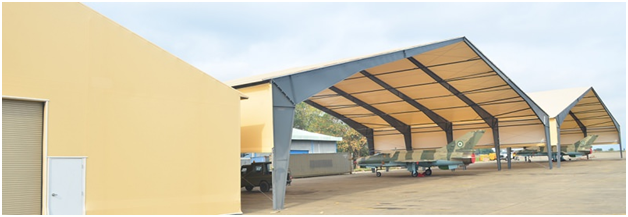A tension fabric building is created using a rigid frame, made of aluminium, steel, wood or rigid plastic. A fabric cover is then stretched over the frame. The fabric is tensioned, so that it provides a stable and structural support for the building.

Benefits
The benefits of choosing a tensioned membrane structure are plentiful. The materials used are all sustainable and environmentally friendly, and by using translucent tensile fabric, maximum daylight is allowed through, thus requiring less electric lighting and reducing costs. The membrane has high sun reflectivity and low absorption of sunlight, thus resulting in less energy used.
Tensioned membrane structures are available in a wide variety of designs, which can include unique and iconic shapes, because of their flexibility. Depending on the type of structure, there are choices of tensile membranes which will meet the specification required. The various tensile membrane systems all meet with the various building code requirements.
Because of its lightweight nature, a tensile structure requires less structural steel support compared to conventional building materials. This allows for longer spans of column free space.
Tensile structures, such as those designed by Fabric Architecture (http://fabricarchitecture.com/), require less maintenance in comparison to a conventional building of the same size. No matter what climate they are built in, from arctic to scorching heat, they are extremely durable and are long lasting.
Types
The common membranes used in these structures are PVC coated polyester fabric, translucent polyurethane fabric, PVC coated glass fibre fabric, PTFE(Polytetrafluoroethylene) fibreglass, ETFE (ethylene tetrafluoroethylene) foil and PVC foil.

PVC is most commonly used for creating flexible structures, and it is usually used for relatively short-term applications. It can also be coated with an acrylic membrane, which gives it a lifespan of 15-20 years.
PTFE is extremely durable and weather resistant and has a life expectancy of some 30 years. The fibreglass weave makes the material strong and permanent.
ETFE is an alternative material to glass, often selected for use in skylights, because it does not degrade when exposed to UV light.
There is no carbon footprint involved with these structures, because they can be taken down and rebuilt on a completely new site, reusing the steel structure.
This innovative modern technology is enabling the design of iconic structures which will be a trademark of the new millennium, using sustainable building materials with low energy costs.
